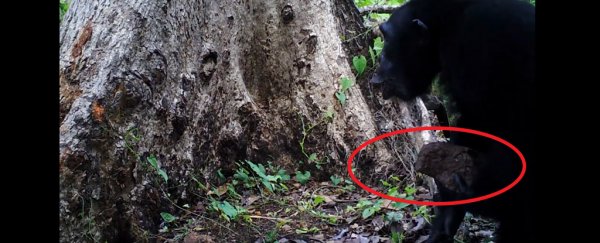Chimpanzees in West Africa have a song, and it goes like this - hoot loudly, and then throw a rock at a tree. Maybe twice. And then saunter away.
Whatever it is our primate cousins are trying to do, we honestly have no idea. But a close look at their choice of instruments just might provide some clues, as the chimps have been observed throwing the rocks at certain types of trees.
Primatologists from the Max Planck Institute for Evolutionary Anthropology in Germany, who first observed this behaviour a few years ago, have now tossed some rocks of their own to determine whether rock-hurling would work as a type of communication.
It's no secret that our primate relatives use stones for a variety of practical purposes, from extracting tortoise fresh from the can to casting them as weapons.
In 2016, the Max Planck primatologists recorded chimpanzees from four wild populations in West Africa hooting excitedly and then throwing a single rock at the wide base of a large tree before running off.
Exactly why they did this wasn't at all clear. There's a sense of something cultural, even ritualistic about the practice. Stones had piled up at the bases of the regularly used tree-drums, suggesting there is something special about those particular instruments.
One possibility is that the clunk-crash noise of the collision communicates a message over long distances, similar to how Australian palm cockatoos might use sticks to bash out a beat in search of a mate.
The researchers were also struck by the fact that the chimps that practiced 'accumulative stone throwing' (AST) didn't throw them at any old type of tree; they returned to the same species time and again.
Maybe the wood had a special quality that carried sound through the forest, like some sort of chimp telegraph service? One that said 'stay clear of us' or 'check out my rock throwing skills, baby!'
"We predicted that chimpanzee AST tree species produce sounds that have energy concentrated at lower frequencies and a greater resonance since these impact sounds would be optimal for long-distance communication," the team writes in their new report.
Unfortunately the footage – which you can check out in the clip below – didn't provide enough sounds the team could use to analyse specific material properties of the wood.
That meant heading out into the field to find examples of AST and similar looking non-AST tree species and hurling rocks at them, chimp style.
Teaming up with researchers from the PRISM (Perception, Representations, Image, Sound, Music) lab at Aix Marseille University in France, the primatologists compared 125 recordings of clunks and thumps made as rocks hit an assortment of trees.
Special algorithms were then used to extract details on three specific properties – the wood's internal friction, which describes the way the sound fades; the hardness of the surface, which describes the sharpness of the strike; and something called the modal response, to give a sense of the spectrum of frequencies.
The researchers also measured the diameters of the trees, and took note of whether the species had decent-sized buttress roots.
In support of their communication hypothesis, the results showed the AST trees hummed with deeper frequencies that could echo over relatively longer distances. Most also had big buttresses that would help boom out a sound.
The timber also produced a longer 'attack time', which also contributed to more drawn-out noise.
The fact the trees all tended to have these features in common indicates the chimps were indeed picking them for their sound quality, which could contribute to a form of non-visual messaging.
It's an interesting result, even if it doesn't get us very far. Unlike the longer sets drummed out by palm cockatoos, these chimp drum solos consist of a single strike or two; hardly a speech worth paying attention to.
What's more, the chimps made a deep hooting sound before they threw the rock, making the whole event feel a little redundant, much like calling out to your neighbour that you were about to send them a single emoji by text.
Speaking to Science Magazine, lead author Ammie Kalan isn't quick to suggest the rock throwing is being done out of sheer pleasure.
"Play behaviour is a little less structured, a little more impromptu," she explained.
On the other hand, our closest relatives are a cultural bunch, and there could be a certain joy in connecting with nature by bashing out a killer beat while sharing your talent with others.
Learning how the chimpanzees select their instruments in the first place could provide more clues on the practice, and potentially help us to better understand how our own ancestors might have used tools to create sounds that elicit emotions.
It might fall short of what we'd think of as music, but our road to rhythm and blues had to start somewhere.
Sadly, with a loss of wild chimpanzee populations comes a loss of these kinds of cultures. If there's a primate music scene out there, we'd better get recording.
This research was published in Biology Letters.
